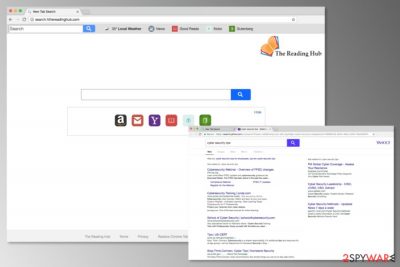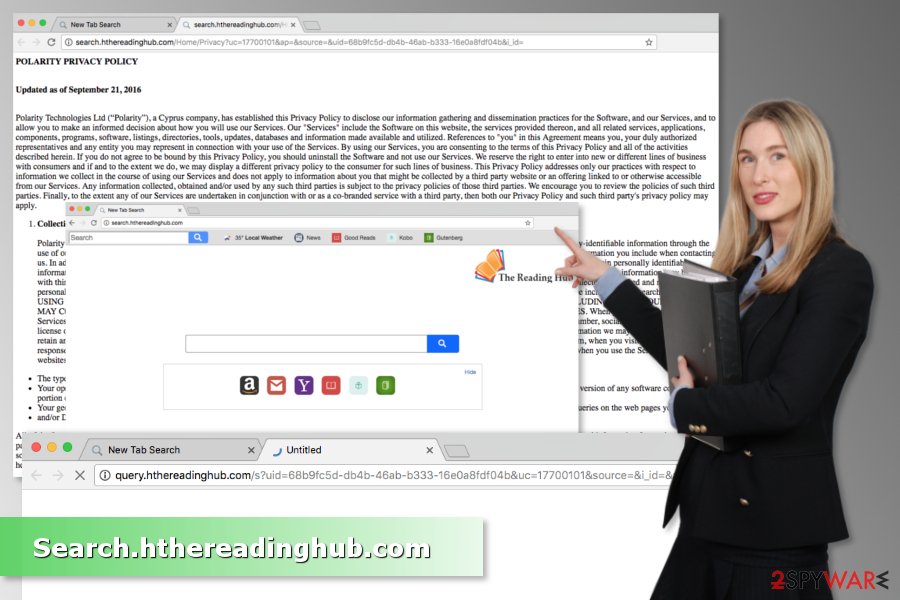Search.hthereadinghub.com (Removal Instructions) - Chrome, Firefox, IE, Edge
Search.hthereadinghub.com Removal Guide
What is Search.hthereadinghub.com?
Search.hthereadinghub.com – a browser hijacker that might alter popular browsers’ settings

Search.hthereadinghub.com is another shady search tool created by Polarity Technologies. This browser hijacker spreads in software bundles as The Reading Hub extension. The browser add-on offers to enhance browsing experience to book lovers. However, the research shows only opposite results.
Search.hthereadinghub.com virus is capable of altering popular browser’s settings, including Mozilla Firefox, Google Chrome, and Internet Explorer. According to the EULA,[1] it also:
- changes default search engine and homepage address;
- replaces built-in search box;
- install unknown toolbars;
- allow installation of tracking cookies.
However, after the Search.hthereadinghub.com hijack, you won’t be able to revert any of these changes. Therefore, you will need to deal with shady redirect tendencies and annoying ads. Keep in mind that questionable data tracking activities might also put your privacy at risk.
The Privacy Policy of the Search.hthereadinghub.com tells that this search tool might collect non-personally identifiable information, such as:
- type of the web browser and operating system;
- IP address;
- technical details about software;
- geographic location;
- the name of ISP;
- browsing history;
- search queries;
- etc.
Additionally, it might share or sell aggregated information with unknown third-parties, including advertising networks. Therefore, the installation of The Reading Hub extension might result in an increased amount of suspicious ads.[2]
The main purpose of the Search.hthereadinghub.com redirect virus is to control users browsing and search activities. Nevertheless, this search tool redirects to Yahoo results; it does not prevent the hijacker to trigger redirects to third-party sites once you click on the link.
Such activity is annoying, but it might also force you to visit phishing, scam or even infected website. Therefore, these redirects should not be tolerated. The only way to stop them is to remove Search.hthereadinghub.com and The Reading Hub extension from the affected browser and computer.
You can perform Search.hthereadinghub.com removal either manually or automatically. You can find manual elimination instructions at the end of the article. However, we highly recommend opting for the automatic elimination method. Scanning the system with reputable anti-malware like FortectIntego ensures that all suspicious files are terminated for good.

Be careful when installing freeware: you might unintentionally give permission to install shady add-ons
The so-called The Reading Hub virus spreads as an optional component in various freeware or shareware packages. Developers take advantage of the popular bundling technique and easily sneaks into computers that belong to inattentive users.
Researchers from the viruset.no[3] note that the majority of users might be the target of potentially unwanted applications because they rely on Standard/Recommended installer. These settings are not designed to disclose about third-party applications that are offered to install together with the primary program. However, if you use them, you give indirect permission to install them.
For this reason, you have to use only Advanced/Custom settings that allow monitoring the installation and opting out unwanted additional downloads.
Two ways to get rid of Search.hthereadinghub.com virus
In order to remove Search.hthereadinghub.com from the browser and set reliable search tool as your default one, you have to uninstall questionable add-ons and look up for other files that might be related to the hijacker.
You can follow manual Search.hthereadinghub.com removal guide below to terminate the PUP yourself. However, if you do not feel capable of completing this task successfully, you should employ a professional anti-malware/anti-spyware.
You may remove virus damage with a help of FortectIntego. SpyHunter 5Combo Cleaner and Malwarebytes are recommended to detect potentially unwanted programs and viruses with all their files and registry entries that are related to them.
Getting rid of Search.hthereadinghub.com. Follow these steps
Uninstall from Windows
Follow these instructions to wipe out all components related to The Reading Hub PUP:
Instructions for Windows 10/8 machines:
- Enter Control Panel into Windows search box and hit Enter or click on the search result.
- Under Programs, select Uninstall a program.

- From the list, find the entry of the suspicious program.
- Right-click on the application and select Uninstall.
- If User Account Control shows up, click Yes.
- Wait till uninstallation process is complete and click OK.

If you are Windows 7/XP user, proceed with the following instructions:
- Click on Windows Start > Control Panel located on the right pane (if you are Windows XP user, click on Add/Remove Programs).
- In Control Panel, select Programs > Uninstall a program.

- Pick the unwanted application by clicking on it once.
- At the top, click Uninstall/Change.
- In the confirmation prompt, pick Yes.
- Click OK once the removal process is finished.
Delete from macOS
These guidelines will help you to get rid of the hijacker manually:
Remove items from Applications folder:
- From the menu bar, select Go > Applications.
- In the Applications folder, look for all related entries.
- Click on the app and drag it to Trash (or right-click and pick Move to Trash)

To fully remove an unwanted app, you need to access Application Support, LaunchAgents, and LaunchDaemons folders and delete relevant files:
- Select Go > Go to Folder.
- Enter /Library/Application Support and click Go or press Enter.
- In the Application Support folder, look for any dubious entries and then delete them.
- Now enter /Library/LaunchAgents and /Library/LaunchDaemons folders the same way and terminate all the related .plist files.

Remove from Microsoft Edge
Delete unwanted extensions from MS Edge:
- Select Menu (three horizontal dots at the top-right of the browser window) and pick Extensions.
- From the list, pick the extension and click on the Gear icon.
- Click on Uninstall at the bottom.

Clear cookies and other browser data:
- Click on the Menu (three horizontal dots at the top-right of the browser window) and select Privacy & security.
- Under Clear browsing data, pick Choose what to clear.
- Select everything (apart from passwords, although you might want to include Media licenses as well, if applicable) and click on Clear.

Restore new tab and homepage settings:
- Click the menu icon and choose Settings.
- Then find On startup section.
- Click Disable if you found any suspicious domain.
Reset MS Edge if the above steps did not work:
- Press on Ctrl + Shift + Esc to open Task Manager.
- Click on More details arrow at the bottom of the window.
- Select Details tab.
- Now scroll down and locate every entry with Microsoft Edge name in it. Right-click on each of them and select End Task to stop MS Edge from running.

If this solution failed to help you, you need to use an advanced Edge reset method. Note that you need to backup your data before proceeding.
- Find the following folder on your computer: C:\\Users\\%username%\\AppData\\Local\\Packages\\Microsoft.MicrosoftEdge_8wekyb3d8bbwe.
- Press Ctrl + A on your keyboard to select all folders.
- Right-click on them and pick Delete

- Now right-click on the Start button and pick Windows PowerShell (Admin).
- When the new window opens, copy and paste the following command, and then press Enter:
Get-AppXPackage -AllUsers -Name Microsoft.MicrosoftEdge | Foreach {Add-AppxPackage -DisableDevelopmentMode -Register “$($_.InstallLocation)\\AppXManifest.xml” -Verbose

Instructions for Chromium-based Edge
Delete extensions from MS Edge (Chromium):
- Open Edge and click select Settings > Extensions.
- Delete unwanted extensions by clicking Remove.

Clear cache and site data:
- Click on Menu and go to Settings.
- Select Privacy, search and services.
- Under Clear browsing data, pick Choose what to clear.
- Under Time range, pick All time.
- Select Clear now.

Reset Chromium-based MS Edge:
- Click on Menu and select Settings.
- On the left side, pick Reset settings.
- Select Restore settings to their default values.
- Confirm with Reset.

Remove from Mozilla Firefox (FF)
Uninstall The Reading Hub or other suspicious extensions that might be responsible for setting Search.hthereadinghub.com as your default search engine.
Remove dangerous extensions:
- Open Mozilla Firefox browser and click on the Menu (three horizontal lines at the top-right of the window).
- Select Add-ons.
- In here, select unwanted plugin and click Remove.

Reset the homepage:
- Click three horizontal lines at the top right corner to open the menu.
- Choose Options.
- Under Home options, enter your preferred site that will open every time you newly open the Mozilla Firefox.
Clear cookies and site data:
- Click Menu and pick Settings.
- Go to Privacy & Security section.
- Scroll down to locate Cookies and Site Data.
- Click on Clear Data…
- Select Cookies and Site Data, as well as Cached Web Content and press Clear.

Reset Mozilla Firefox
If clearing the browser as explained above did not help, reset Mozilla Firefox:
- Open Mozilla Firefox browser and click the Menu.
- Go to Help and then choose Troubleshooting Information.

- Under Give Firefox a tune up section, click on Refresh Firefox…
- Once the pop-up shows up, confirm the action by pressing on Refresh Firefox.

Remove from Google Chrome
In order to get back control over Google Chrome, you have to delete unknown add-ons and reset the browser as shown below:
Delete malicious extensions from Google Chrome:
- Open Google Chrome, click on the Menu (three vertical dots at the top-right corner) and select More tools > Extensions.
- In the newly opened window, you will see all the installed extensions. Uninstall all the suspicious plugins that might be related to the unwanted program by clicking Remove.

Clear cache and web data from Chrome:
- Click on Menu and pick Settings.
- Under Privacy and security, select Clear browsing data.
- Select Browsing history, Cookies and other site data, as well as Cached images and files.
- Click Clear data.

Change your homepage:
- Click menu and choose Settings.
- Look for a suspicious site in the On startup section.
- Click on Open a specific or set of pages and click on three dots to find the Remove option.
Reset Google Chrome:
If the previous methods did not help you, reset Google Chrome to eliminate all the unwanted components:
- Click on Menu and select Settings.
- In the Settings, scroll down and click Advanced.
- Scroll down and locate Reset and clean up section.
- Now click Restore settings to their original defaults.
- Confirm with Reset settings.

Delete from Safari
Remove unwanted extensions from Safari:
- Click Safari > Preferences…
- In the new window, pick Extensions.
- Select the unwanted extension and select Uninstall.

Clear cookies and other website data from Safari:
- Click Safari > Clear History…
- From the drop-down menu under Clear, pick all history.
- Confirm with Clear History.

Reset Safari if the above-mentioned steps did not help you:
- Click Safari > Preferences…
- Go to Advanced tab.
- Tick the Show Develop menu in menu bar.
- From the menu bar, click Develop, and then select Empty Caches.

After uninstalling this potentially unwanted program (PUP) and fixing each of your web browsers, we recommend you to scan your PC system with a reputable anti-spyware. This will help you to get rid of Search.hthereadinghub.com registry traces and will also identify related parasites or possible malware infections on your computer. For that you can use our top-rated malware remover: FortectIntego, SpyHunter 5Combo Cleaner or Malwarebytes.
How to prevent from getting stealing programs
Stream videos without limitations, no matter where you are
There are multiple parties that could find out almost anything about you by checking your online activity. While this is highly unlikely, advertisers and tech companies are constantly tracking you online. The first step to privacy should be a secure browser that focuses on tracker reduction to a minimum.
Even if you employ a secure browser, you will not be able to access websites that are restricted due to local government laws or other reasons. In other words, you may not be able to stream Disney+ or US-based Netflix in some countries. To bypass these restrictions, you can employ a powerful Private Internet Access VPN, which provides dedicated servers for torrenting and streaming, not slowing you down in the process.
Data backups are important – recover your lost files
Ransomware is one of the biggest threats to personal data. Once it is executed on a machine, it launches a sophisticated encryption algorithm that locks all your files, although it does not destroy them. The most common misconception is that anti-malware software can return files to their previous states. This is not true, however, and data remains locked after the malicious payload is deleted.
While regular data backups are the only secure method to recover your files after a ransomware attack, tools such as Data Recovery Pro can also be effective and restore at least some of your lost data.
- ^ What Are EULAs and Why Should I Read Them?. Dartmouth College. Tech tips and tricks.
- ^ Mike Sunnucks. Why annoying online ads are more dangerous than you think. The Business Journals. Business news.
- ^ Viruset. Viruset. Latest cyber security news from Norway.























